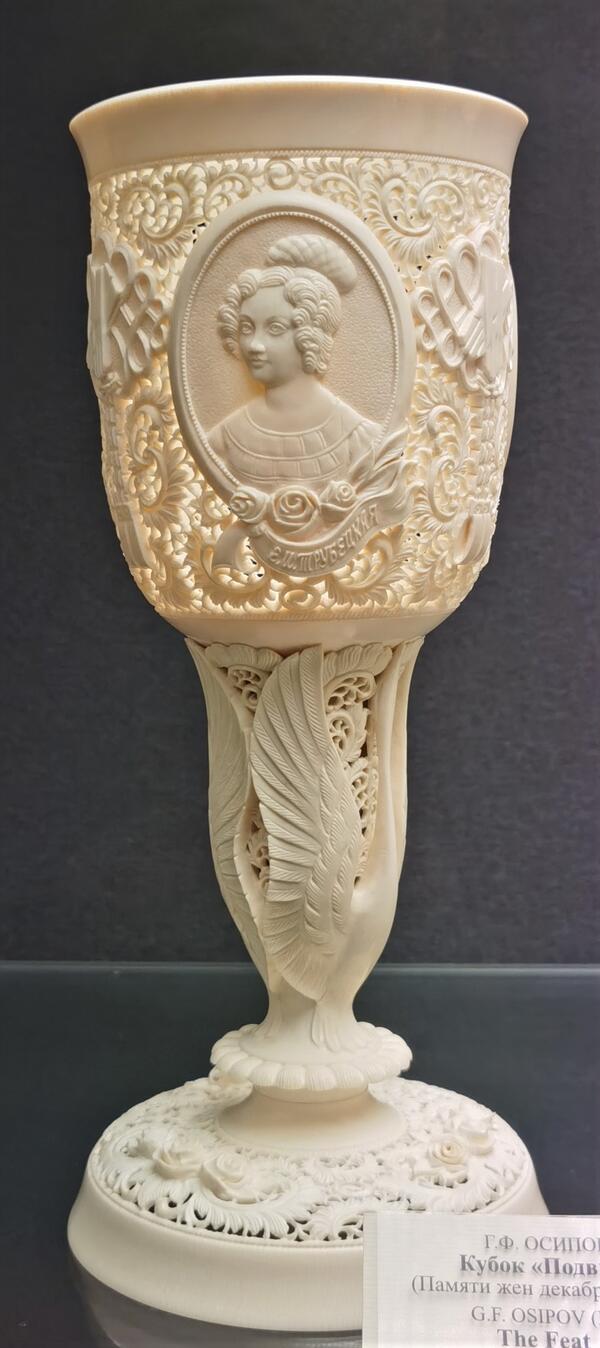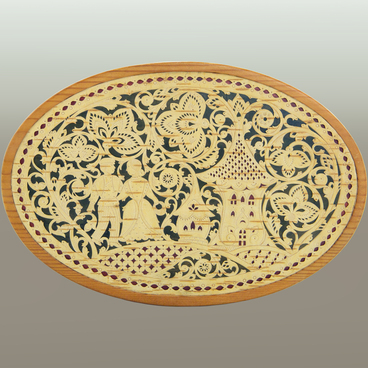In the Russian North, on the islands of the Northern Dvina River near the city of Kholmogory, for more than 400 years people have practiced bone carving, using walrus ivory tusks, fossilized ivory from woolly mammoths and bones of domestic animals. At all times, caskets, cups, and vases were carved from bone and used as a rich interior decoration or even a diplomatic gift. The 18th century was the heyday of this art influenced by the Baroque style. There was in increasing demand for wooden boxes decorated with openwork bone plates. An exquisite openwork scroll — curves resembling shells — against a background of red foil covered with mica served as an elegant frame for relief images of hunting scenes: running hares, dogs and riders.
In the 1950s–1970s, the Kholmogory craftsmen studied the richest collections of carved bones in the Historical Museum, the Hermitage, and the Russian Museum. This helped them to improve their understanding of the subject and develop the local artistic tradition.
The goblet titled “The Feat of Love” was created by the artist Gennady Fyodorovich Osipov, one of the outstanding masters of bone carving in the village of Lomonosovo.
The goblet with a dramatic glorious silhouette is made of mammoth tusk. The openwork bowl is decorated with relief medallions featuring the portraits of Decembrists wives: Maria Nikolaevna Volkonskaya, Alexandra Grigorievna Muravyova and Ekaterina Ivanovna Trubetskaya. The openwork pattern surrounding the medallions is formed by the Kholmogory scroll. The sharp edges of the shell make the pattern look especially dynamic and emphasize the vividness of the medallions and relief inlays depicting a pair of ladies’ gloves and chains with shackles.
The goblet has a slightly flaring smooth polished edge. The natural mesh pattern of the mammoth ivory tusk, its transparency and creamy color emphasize the richness of the carved decoration.
The stem is made in the shape of two sculpted swans supporting the cup with their raised wings. The swan symbolizes fidelity, emphasizing the figurative meaning of the work. A branch with roses and a fluttering ribbon under the medallion are a symbol of admiration for the deed of Decembrist wives.
In the 1950s–1970s, the Kholmogory craftsmen studied the richest collections of carved bones in the Historical Museum, the Hermitage, and the Russian Museum. This helped them to improve their understanding of the subject and develop the local artistic tradition.
The goblet titled “The Feat of Love” was created by the artist Gennady Fyodorovich Osipov, one of the outstanding masters of bone carving in the village of Lomonosovo.
The goblet with a dramatic glorious silhouette is made of mammoth tusk. The openwork bowl is decorated with relief medallions featuring the portraits of Decembrists wives: Maria Nikolaevna Volkonskaya, Alexandra Grigorievna Muravyova and Ekaterina Ivanovna Trubetskaya. The openwork pattern surrounding the medallions is formed by the Kholmogory scroll. The sharp edges of the shell make the pattern look especially dynamic and emphasize the vividness of the medallions and relief inlays depicting a pair of ladies’ gloves and chains with shackles.
The goblet has a slightly flaring smooth polished edge. The natural mesh pattern of the mammoth ivory tusk, its transparency and creamy color emphasize the richness of the carved decoration.
The stem is made in the shape of two sculpted swans supporting the cup with their raised wings. The swan symbolizes fidelity, emphasizing the figurative meaning of the work. A branch with roses and a fluttering ribbon under the medallion are a symbol of admiration for the deed of Decembrist wives.



